fog light BUICK ROADMASTER 1993 Owners Manual
[x] Cancel search | Manufacturer: BUICK, Model Year: 1993, Model line: ROADMASTER, Model: BUICK ROADMASTER 1993Pages: 340, PDF Size: 18.34 MB
Page 14 of 340
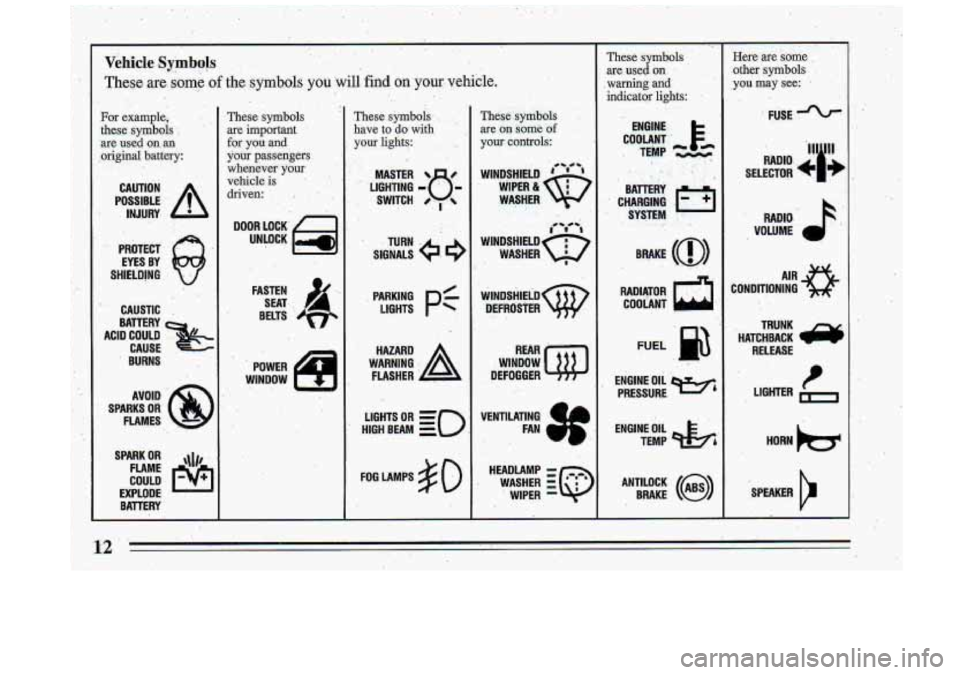
Vehicle Symbols . , . '
mcese are some .of the,symbols you will find on your vehicle. . ' . '".' . '*
I. .. . .- . .* . t . . :.
.. ... .. , I. .'
For example,
these symbols
'
are used on an
original battery:
CAUTION
INJURY
..
POSSIBLE: .' A
.' PR~TECT @
EYES BY
SHIELDING
CAUSTIC
ACID COULD
&
BATTERY CAUSE
BURNS
SPARKS AVOID
OR '"8
FLAMES
COULD
EXPLODE BATTERY
I,
These symbols
are
important
for you.and.
your passengers
whenever your
vehicle-is- ' .
driven: ~ , E , .. , .,
iI
..
DOOR LOCK,' f 1
UNLOCK e
SEAT,
BELTS
WlNDOW
f -1
POWER
These symbols, . _.
have to'do with , .
your lights: ' ,. , - .<
*_
' 'LIGHTING
-8-
MASTER %. . 8
. 'SWITCH /., .
PARKING pf
LIGHTS
HAZARD
WARNING
:A
FLASHER
HIGH
'IGHTS BEAM OR = =o
,. T.hese symbols ',
are on some bf
your controls.:
WIN'DSHIELD. ' ' ' 0- c,
WIPER a Q
WINDSHIELDQ WASHER
** ri I91
WASHER I
. WlNDSHlELD(fji)
DEFROSTER
,) .
WINDOW
DEFOGGER
' WASHER EG
HEADLAMP -
WIPER
These symbols
are used on '
,warning and
indicator lights:
RADIATOR COOLANT
FUEL
ENGINE OIL 'e,
PRESSURE
TEMP
Oli 4%
ANTILOCK. (a)
BRAKE
Bere are some
other symbols
,you may see:
FUSE
RADIO.
CONDITIONING ..
TRUNK
HATCHBACK
e
RELEASE --
LIGHTER e,
SPEAKER
b
?
Page 92 of 340
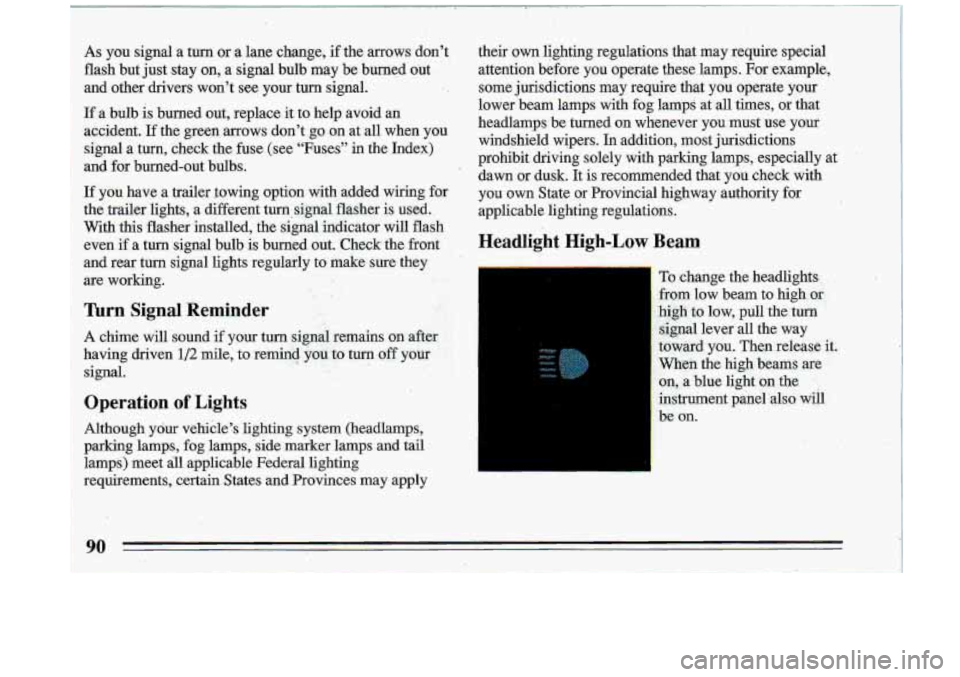
As you signal a turn or a lane change, if the arrows don't
flash but just stay on, a signal bulb may be burned out
and other drivers won't see your turn signal.
If a bulb is burned out, replace it to help avoid an
accident. If the green arrows don't go on at all when you
signal a turn, check the fuse (see "Fuses" in the Index)
and for burned-out bulbs.
If you have a trailer towing option with added wiring for
the .trailer lights, a different
turn signal flasher is used.
With this flasher installed, the signal indicator will flash
even if
a turn signal bulb is burned out. Check the front
and rear turn signal lights regularly to make sure they
are working.
Turn Signal Reminder
A chime will sound if your turn signal remains on after
having driven
1/2 mile, to remind you to turn off your
signal.
Operation of Lights
Although your vehicle's lighting system (headlamps,
parking lamps, fog lamps, side marker lamps and tail
lamps) meet all applicable Federal lighting
requirements, certain States and Provinces may apply their own lighting regulations that may require special
attention before you operate these lamps. For.example,
some jurisdictions may require that you operate your
lower beam lamps with fog lamps at -all times, or that
headlamps. be turned
on whenever you.must use your
windshield wipers. In addition, most jurisdictions
prohibit driving solely with parking lamps, especially at
dawn or dusk. It is recommended that you check with
you own State or Provincial highway authority. for
applicable lighting regulations.
Headlight High-Low Beam
To change the headlights.
l .from low beam to high or..'
:hi:& -to low, pull the turn
signal lever all the way
'toward you. Then .release it.
When the high beams are
on, a blue light, on the
instrument panel -also will
be on.
90
Page 135 of 340
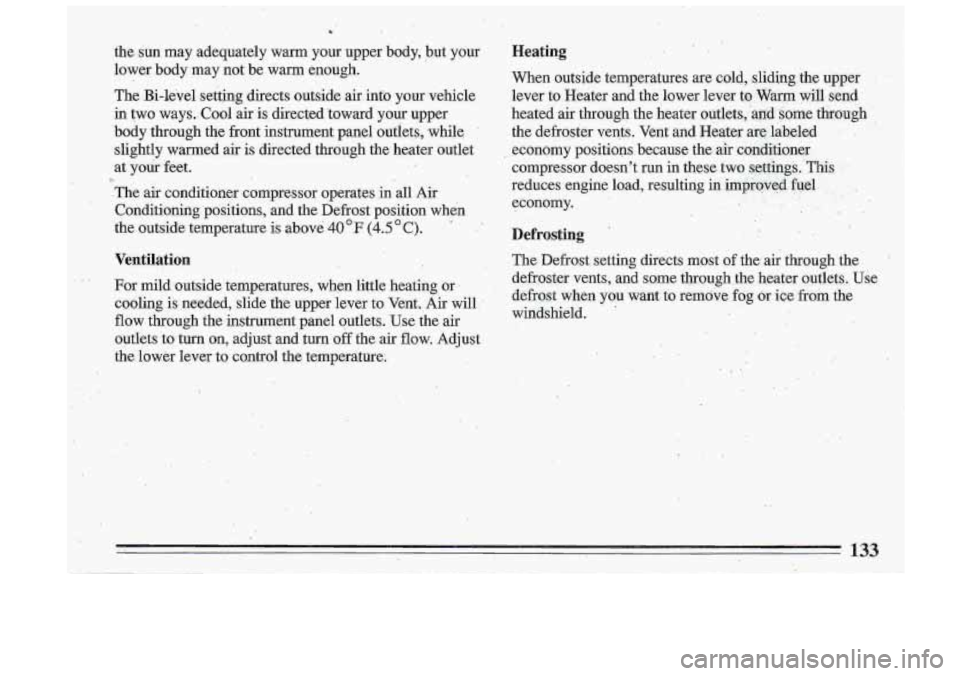
i
the sun may adequately warm your upper body, but your
lower body may not be warm enough.
The Bi-level settbg directs outside air.into your vehicle
in two ways.-Cool air
is directed 'toward your upper
body through the front instrument panel outlets, ,while
slightly warmed
air is directed through the heater outlet
at
your feet.
.The air conditioner compressor operates in all Air
Conditioning positions, and the Defrost position when
.the outside temperature is above
40 OF (4.5 C).
R
Ventilation
For mild outside temperatures, when little heating ox ,
cooling is needed, slide the upper lever to Vent, Air will,'
flow through the .instrument panel outlets. Use the air
oudets to turn on, adjust and turn
off the air, flow. Adjust.
the lower lever to control the temperature;
'.
.. .
Heating
When outside temperatures are cold, 8liding:the upper .
lever to Heater and the' lower lever to :Warm will send,
heated air though the heater outlets, 'and-some through
the defroster vents. Vent and Heater arelabeled
economy positions. because the
dr conditioner
compres.sor doesn't run in these..two settings. "This . .
reduces engine load, resulting in impioyed I.. fyd.
economy.
Defrosting
The Defrost setting directs most of the- air through the
defroster vents, and some through.the heater outlets. Use
defrost when you want to remove fog
,6r ice from the
windshield.
133
Page 182 of 340
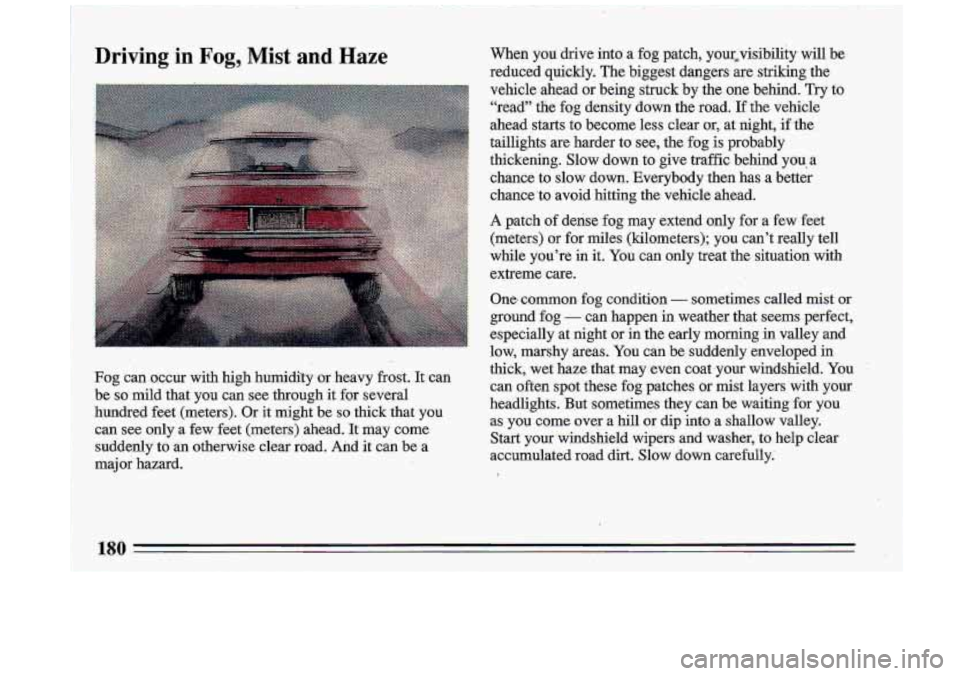
Driving in Fog, Mist and Haze When you drive into a fog patch, your$sibility will be
reduced quickly. The biggest dangers
are striking the
vehicle ahead or being struck by the
one behind. Try to
‘‘read” the fog density down the road.
If the vehicle
ahead starts to become less clear
or, at night; if the
taillights are harder to see,
-the fog is probably
thickening. Slow down to give- traffic behind you. a
chance to slow down. Everybody then has a better chance.to avoid hitting the vehicle ahead.
A patch of derise fog may extend only for a few feet
(meters) or for miles (kilometers); you can’t really tell
while you’re
in it. You can only treat ‘the situation with
extreme tare.
One, common fog condition - sometimes called mist or
ground fog - can happen in weather that seems perfect,
especially at night or in the early
morning in valley and
low, marshy areas. You can be suddenly enveloped
in
thick, wet haze that may even coat ,your windshield. You
can often spot these fog patches .or mist layers with
your
headlights. But sometimes they can be waiting for you
as you come over a hill or dip into a. shallow valley.
Start your windshield wipers and washer, to help clear
accumulated road dirt. Slow down carefully.’
Fog can occur with high humidity or heavy frost. It can
be
so mild that- you can see through it for several
hundred feet (meters). Or-it might
he so thick .that you
can see only
a few feet (meters) ahead. It may come
suddenly
to an otherwise clear road. And it can be a
major hazard.
Page 183 of 340
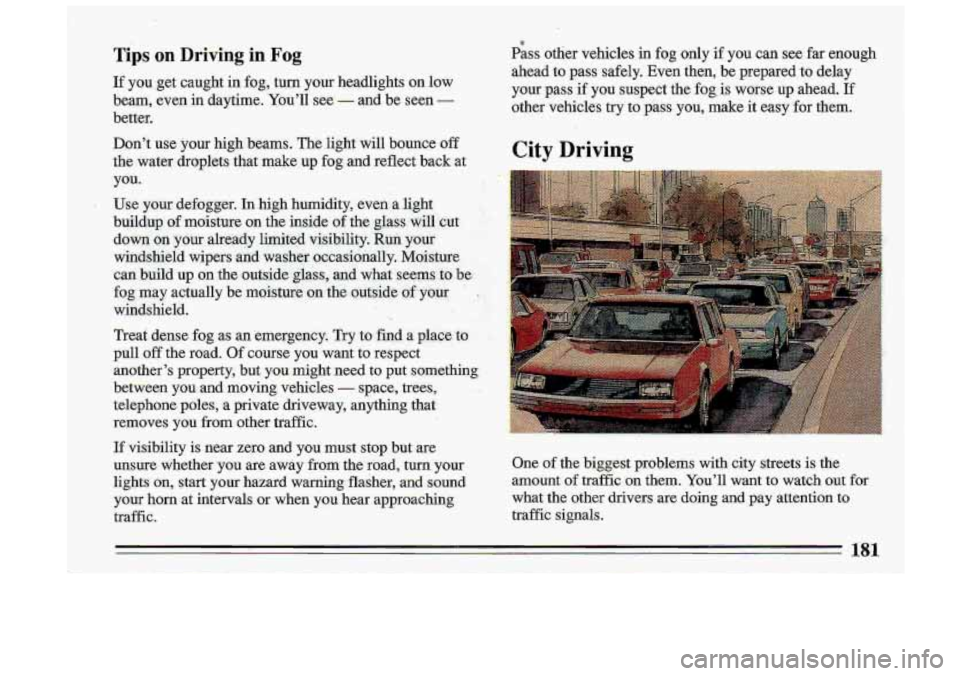
Tips on Driving in Fog
If you get caught in fog, turn your headlights on low
beam, even in daytime. You’ll see
- and be seen -
better.
Pass other vehicles in fog only if you can see far enough
ahead to pass safely. Even then, be prepared to delay
your pass if you suspect the
fog.is worse up ahead. If
other vehicles try to pass you, make it easy for them.
*
If visibility is near zero and you must stop but are
unsuTe whether you are away
from the road, turn your
lights on, start
your hazard warning flasher, and sound
your
Born at intervals or when you hear approaching
traffic. One
of the
biggest problems with city streets is the
amount of traffic
on them. You’ll want to watch out for
what the other drivers are doing and pay attention
to
traffic signals.
181
Page 284 of 340
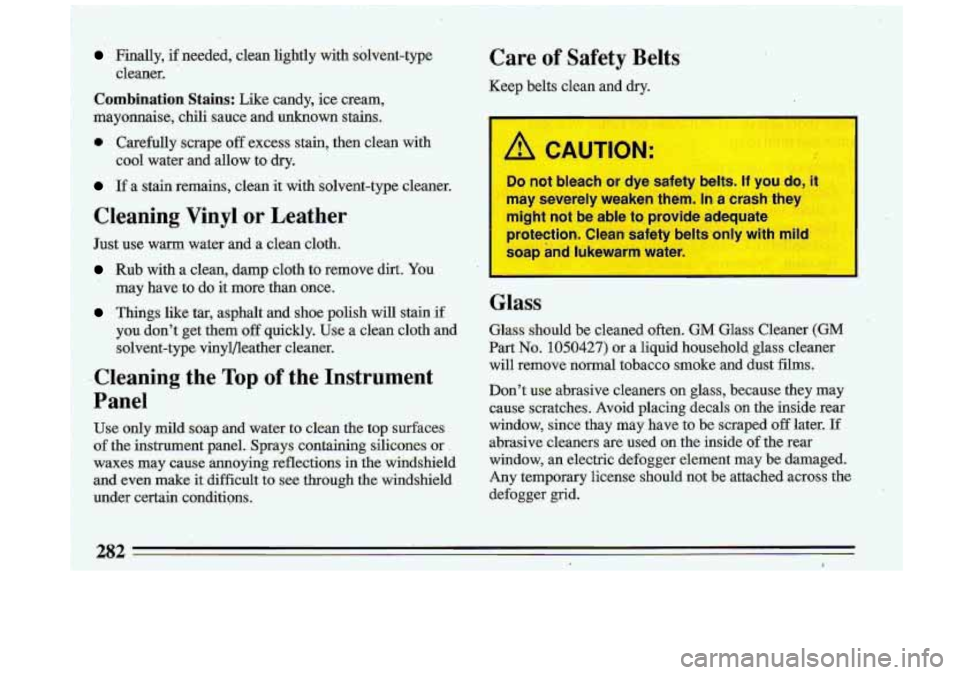
Finally, if needed, clean lightly with solvent-type Care of Safety Belts
cleaner.
Combination Stains: Like candy, ice cream,
mayonnaise, chili sauce and unknown stains.
@ Carefully scrape off excess stain, then clean with
If a stain remains, clean it with solvent-type cleaner.
cool water and allow to dry.
Cleaning Vinyl .or Leather
Just use warm water and a clean cloth.
Rub with a clean, damp cloth to remove dirt. You
may have to do it more than once.
Things
like tar, asphalt and shoe polish will stain if
you don’t get them off quickly. Use a clean.-clQth -and.
solvent-type vinylfleather cleaner.
Cleaning the Top of the Instrument
Panel
Use only mild soap and water to clean the top surtaces
,of the instrument panel. Sprays containing silicones or
.
waxes may cause annoying reflections in the windshield
and even make
it difficult to see through the windshield
under certain conditions.
-
Keep belts clean and dry.
/L CAUTIOC
Do not bleach or dye satety belts. IT you UO, I
may severely weaken them. In a crash they
might not
be able to provide adequate
protection. Clean safety belts only with
mi
soap and lukewarm water.
I
Glass
Glass should be cleaned often. GM Glass Cleaner (GM
Part No. 1050427) or a liquid household! glass cleaner
will remove normal tobacco smoke and dust films.
Don’t use abrasive cleaners on glass, because they may
cause scratches. Avoid placing decals
OR the inside rear
window, since thay may have to be scraped
off later. If
abrasive cleaners are used on the inside of the rear
window, an electric defogger element may be damaged.
Any temporary license should not be attached across the defogger grid.